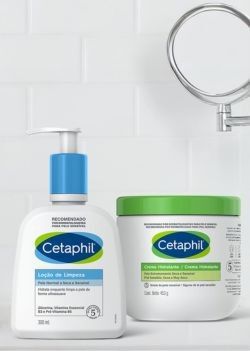
VIMOS QUE VOCÊ ESTÁ EM UMA LOCALIZAÇÃO DIFERENTE
Para uma experiência otimizada, visite nosso site clicando aqui:
MUDAR SITE
Para uma experiência otimizada, visite nosso site clicando aqui:
MUDAR SITE
1. American Academy of Dermatology Association (AAD)
2. Benefits of Niacinamide (Vitamin B3). Cleveland Clinic. Disponível em: https://health.clevelandclinic.org. Acesso em: 25 jun. 2024.
3. Camargo, F., Gaspar, L. and Pm, M. (2011) "Skin moisturizing effects of panthenol-based formulations.", Journal of Cosmetic Science, p. Available at: https://www.scinapse.io/papers/3564442 (Acessado em: 14 de maio de 2024).
4, Spada, F., Lui, A. and Barnes, T. (2019) "Use of formulations for sensitive skin improves the visible signs of aging, including wrinkle size and elasticity", Clinical, Cosmetic and Investigational Dermatology, Volume 12, pp. 415-425. doi: 10.2147/ccid.s212240.
5. Rotondo, F. et al. (2017) "Glycerol is synthesized and secreted by adipocytes to dispose of excess glucose, via glycerogenesis and increased acyl-glycerol turnover", Scientific Reports, 7(1). doi: 10.1038/s41598-017-09450-4. [Acessado em: https://www.nature.com/articles/s41598-017-09450-4 ]
6. Roussel, L., Atrux-Tallau, N. and Pirot, F. (2012) ‘Glycerol as a Skin Barrier Influencing Humectant’. Treatment of Dry Skin Syndrome, pp. 473-480. [Acessado em: https://link.springer.com/chapter/10.1007/978-3-642-27606-4_32]
7. Milani, M. and Sparavigna, A. (2017) ‘The 24-hour skin hydration and barrier function effects of a hyaluronic 1%, glycerin 5%, and Centella asiatica stem cells extract moisturizing fluid: an intra-subject, randomized, assessor-blinded study’. Clinical, Cosmetic and Investigational Dermatology, 10, pp. 311-315. [Acessado em:https://www.ncbi.nlm.nih.gov/pmc/articles/PMC5560567]
8. Juncan, A. M., Moisă, D. G., Santini, A., Morgovan, C., Rus, L.-L., Vonica-Țincu, A. L., & Loghin, F. (2021). “Advantages of Hyaluronic Acid and Its Combination with Other Bioactive Ingredients in Cosmeceuticals”. Molecules, 26(15), 4429. https://doi.org/10.3390/molecules26154429
9. Zhu, J. Tang, X. Jia, Y. Ho, C. Huang, Q. (2020). “Applications and delivery mechanisms of hyaluronic acid used for topical/transdermal delivery – A review”. International Journal of Pharmaceutics, volume 578, 2020. https://doi.org/10.1016/j.ijpharm.2020.119127
10. Meckfessel, M. and Brandt, S. (2014) "The structure, function, and importance of ceramides in skin and their use as therapeutic agents in skin-care products", Journal of the American Academy of Dermatology, 71(1), pp. 177-184. doi: 10.1016/j.jaad.2014.01.891.
11. Wattenberg, B. (2018) "The long and the short of ceramides", Journal of Biological Chemistry, 293(25), pp. 9922-9923. doi: 10.1074/jbc.h118.003522.
12. Traber, M. G., & Atkinson, J. (2007). Vitamin E, antioxidant and nothing more. Free Radical Biology and Medicine, 43(1), 4-15.
13. Baumann, L. (2009). Cosmetic Dermatology: Principles and Practice (2nd ed.). McGraw-Hill Professional